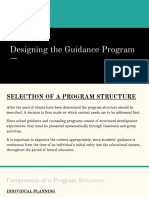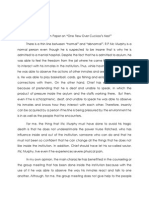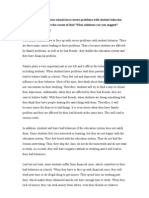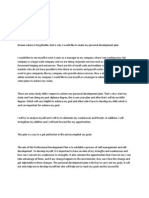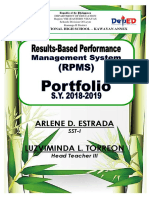4 Components of A Guidance Program
4 Components of A Guidance Program
Uploaded by
Anna OhCopyright:
Available Formats
4 Components of A Guidance Program
4 Components of A Guidance Program
Uploaded by
Anna OhOriginal Title
Copyright
Available Formats
Share this document
Did you find this document useful?
Is this content inappropriate?
Copyright:
Available Formats
4 Components of A Guidance Program
4 Components of A Guidance Program
Uploaded by
Anna OhCopyright:
Available Formats
American School Counselor Association (ASCA) National School Counseling Model, 2003
District 11 Comprehensive Counseling and Guidance Program Development Guide
Comprehensive Counseling and Guidance Program Overview
Four Components of a Comprehensive Counseling Program
GUIDANCE CURRICULUM
INDIVIDUAL PLANNING
RESPONSIVE SERVICES
SYSTEM SUPPORT
Provides guidance content in a
systematic way for the purpose of skill
development and application of skills
learned
Assists students in planning,
monitoring, and managing their
educational, personal/social, and
career development goals
Addresses the immediate concerns of
learners. The purpose is prevention,
intervention, and referral as
needed
Includes program, staff, and school
support activities and services. The
purpose is to provide leadership and
support in program delivery
Topics Addressed:
Topics Addressed:
Topics Addressed:
Topics Addressed:
Academic Development
Skill development
Planning course of study
Employment skill development
Workforce Preparation
Transitions
Career Development
Secondary and Post-Secondary
Academic Development
Academics
Attendance
Behavior
Drop-out prevention
Special needs
Accommodations
Career Planning
Secondary and Post-Secondary
Guidance program development,
implementation, and assessment
Parent education
Faculty/administrator consultation
Staff development for educators
Counselor professional development
Incorporation of educational initiatives
into one of the four guidance
components
Research and publishing
Community outreach
Public relations
Building Assistance Teams
Crisis Management Plan
Comprehensive Study Skills program
School Improvement initiatives
Special initiatives to address behavior
and learning
Planning
Career awareness
Career exploration
Career decision-making
Career transitions
Personal/Social Development
Goal Setting
Diversity Awareness
Character education
Violence prevention
Substance abuse prevention
Academic Development
Setting and following educational
goals
Transitioning needs
3-Year and 4-Year course plans
Alternative education options
Career Development
Secondary and Post-Secondary
Planning
Career assessments
Job shadowing, mentors,
internships, apprenticeships
Personal/Social Development
All topics under Guidance
Curriculum in an individual and
more personalized setting
Planning
Assist in identification of
support systems
Addressing special needs
Personal/Social Development
Peer conflicts
Coping with stress
Crisis management
Grief/loss/death
Relationship concerns
Abuse
Substance Abuse
Counselor Role
Counselor Role
Counselor Role
Counselor Role
Classroom instruction
Leadership and consultation
Structured Groups
Assessment
Planning and placement
Individual conference planning,
implementation, and assessment
Individual and small group, crisis
and developmental counseling
Consultation
Referral to outside agencies
Provide leadership, facilitative, and
organization skills in:
Program management
Leadership and consultation
Alignment with SIP and DIP
Alignment with SIP and DIP
Alignment with SIP and DIP
Alignment with SIP and DIP
Secondary and Post-Secondary
plans and skills in place as
measured by:
Credit Deficiency rates decreased
Successful promotion to HS
Graduation rate increased
Drop-out rate decreased
Secondary and Post-Secondary
plans and skills in place as
measured by:
Credit Deficiency rates decreased
Successful promotion to HS
Graduation rate increased
Drop-out rate decreased
Academic time and skills
maximized as measured by:
Successful promotion to HS
Graduation rate increased
Drop-out rate decreased
School and Department
Improvement Plan goals met
You might also like
- Guidance and Counseling ReviewerDocument6 pagesGuidance and Counseling Reviewertototo100% (6)
- IPCRF of Guidance CouncelorDocument20 pagesIPCRF of Guidance Councelorjhunma20002817100% (10)
- Prospective Budget For The School Counseling DepartmentDocument2 pagesProspective Budget For The School Counseling Departmentapi-23058654075% (4)
- Guidance and Counselling: Foundations and PracticeFrom EverandGuidance and Counselling: Foundations and PracticeRating: 3.5 out of 5 stars3.5/5 (4)
- Role of Communities in Community Development and Social ChangeDocument7 pagesRole of Communities in Community Development and Social ChangeAnna Oh100% (5)
- Student Needs AssessmentDocument4 pagesStudent Needs Assessmentapi-285240070No ratings yet
- Syllabus For Organization, Administration and Supervision of Guidance ServicesDocument17 pagesSyllabus For Organization, Administration and Supervision of Guidance ServicesPearl Via Soliven Coballes100% (5)
- Guidance ServicesDocument56 pagesGuidance Servicesminna comuyogNo ratings yet
- Proposed Guidance Strategic PlanDocument9 pagesProposed Guidance Strategic PlanArjay Andanar100% (4)
- GUIDANCE SERVICES Individual Inventory ServiceDocument15 pagesGUIDANCE SERVICES Individual Inventory ServiceNitin Sharma100% (1)
- Evaluation Questionnaire For Guidance Services OfficeDocument9 pagesEvaluation Questionnaire For Guidance Services OfficeReena Rose Abonales100% (3)
- Peer Facilitation ProgramDocument4 pagesPeer Facilitation ProgramAngelica Nichole75% (4)
- Guidance Center Handbook ManualDocument5 pagesGuidance Center Handbook ManualLovely Cruzat100% (1)
- Crash Course Guidance and Counseling (PGCA Webinar Series)Document21 pagesCrash Course Guidance and Counseling (PGCA Webinar Series)Cherry Ann De VeraNo ratings yet
- Guidance and Counseling Services DepEdDocument46 pagesGuidance and Counseling Services DepEdLagno Bautista Ruel Jr.100% (3)
- Needs Assessment FormDocument3 pagesNeeds Assessment FormMichelle PañaNo ratings yet
- Evaluation of Guidance ServicesDocument43 pagesEvaluation of Guidance ServicesFelix Zabanal100% (3)
- Guidance Counselor CoordinatorDocument12 pagesGuidance Counselor CoordinatorJohn CarterNo ratings yet
- Guidance PersonnelDocument12 pagesGuidance PersonnelJona Addatu86% (7)
- Designing The Guidance ProgramDocument18 pagesDesigning The Guidance ProgramjessicaNo ratings yet
- OUTLINE Introduction To Guidance and CounselingDocument3 pagesOUTLINE Introduction To Guidance and Counselingdocasif78% (9)
- Guidance Services Matrix-Action PlanDocument18 pagesGuidance Services Matrix-Action PlanSarah Jane Lagura Rele100% (9)
- Individual Inventory Services in Guidance and Counseling: AbstarctDocument11 pagesIndividual Inventory Services in Guidance and Counseling: Abstarctodessa kaye abacahinNo ratings yet
- Student Individual Inventory FinalDocument4 pagesStudent Individual Inventory FinalMercedita Balgos100% (3)
- Historical and Philosophical Perspective of Guidance Power PointDocument12 pagesHistorical and Philosophical Perspective of Guidance Power PointYep Yep60% (5)
- Reflection Paper On The Movie "I Am Sam"Document3 pagesReflection Paper On The Movie "I Am Sam"Anna Oh71% (14)
- Djpres Guidance Program ProposalDocument9 pagesDjpres Guidance Program ProposalVicky Gualin100% (4)
- Guidance and CounselingDocument12 pagesGuidance and CounselingCarla Joyce75% (4)
- Model Guidance Program For Secondary Schools in The Division of CatanduanesDocument58 pagesModel Guidance Program For Secondary Schools in The Division of CatanduanesJesslyn Torres Taway100% (1)
- Organization and Administration of GuidanceDocument2 pagesOrganization and Administration of GuidanceJOSE FERNANDO GEMPERLE100% (1)
- Comprehensive Guidance ProgramDocument11 pagesComprehensive Guidance ProgramAdie Caberte100% (3)
- Comprehensive Guidance ProgramDocument8 pagesComprehensive Guidance ProgramKen Paul Balcueva100% (2)
- Individual Inventory Service: The Guidance Services Guidance ServicesDocument21 pagesIndividual Inventory Service: The Guidance Services Guidance ServicesDhon ValeNo ratings yet
- Prevention and Wellness by VillarDocument3 pagesPrevention and Wellness by Villarmary100% (1)
- Organization Administration of GuidanceDocument49 pagesOrganization Administration of GuidanceJomar BumidangNo ratings yet
- Pgca Code of Ethics 2021Document20 pagesPgca Code of Ethics 2021Gwyneth Alethea GumapacNo ratings yet
- Guidance ProgramDocument169 pagesGuidance ProgramAr Jay Juan100% (2)
- Guidance Program (Guidance Services)Document4 pagesGuidance Program (Guidance Services)Arnol Candare100% (1)
- Guidance and Counseling Program - MechanicsDocument4 pagesGuidance and Counseling Program - MechanicsCheska Temones33% (3)
- Mikeas Kent Esteban Comprehensive Guidance Program and ServicesDocument3 pagesMikeas Kent Esteban Comprehensive Guidance Program and ServicesRemil Angelo GarciaNo ratings yet
- Guidance ProgramDocument8 pagesGuidance ProgramJoerel AganonNo ratings yet
- Guidance ServicesDocument63 pagesGuidance ServicesCLETUS BATTON100% (1)
- Guidance Office Action PlanDocument9 pagesGuidance Office Action PlanAngelica Almeda100% (1)
- MODEL GUIDANCE PROGRAM For Secondary SchoolsDocument42 pagesMODEL GUIDANCE PROGRAM For Secondary SchoolsHelma100% (4)
- Basic Guidance ServicesDocument6 pagesBasic Guidance ServicesMJ Fango86% (7)
- School Guidance Program - FinalDocument4 pagesSchool Guidance Program - FinalLoreto C. Morales82% (11)
- Deped Mission: Philippine Normal University NationalDocument3 pagesDeped Mission: Philippine Normal University NationalAngelicaGonzalesNo ratings yet
- Junior High School Guidance ProgramDocument12 pagesJunior High School Guidance ProgramRodel Ramos Daquioag100% (2)
- Guidance ServicesDocument16 pagesGuidance ServicesMartina SilerioNo ratings yet
- 01 Tutorial 1 - Guidance, Counseling and PsychotherapyDocument6 pages01 Tutorial 1 - Guidance, Counseling and Psychotherapyopheliaviolet100% (3)
- Measurement, Evaluation, and Techniques Used in Guidance and CounsellingDocument7 pagesMeasurement, Evaluation, and Techniques Used in Guidance and CounsellingUchihaLunaNo ratings yet
- Group ProcessDocument3 pagesGroup ProcessPhao GonzalesNo ratings yet
- Career Guidance ProgramDocument3 pagesCareer Guidance ProgramRose Marni MandingNo ratings yet
- Comprehensive GuidanceDocument26 pagesComprehensive Guidancelehsem20006985No ratings yet
- Guidance and CounsellingDocument6 pagesGuidance and CounsellingChristy Ubana100% (3)
- Course Code: Educ 2016 Philosophical, Psychological and Sociological Foundations of GuidanceDocument4 pagesCourse Code: Educ 2016 Philosophical, Psychological and Sociological Foundations of GuidanceCheska Temones0% (1)
- Sample IpcrfDocument4 pagesSample IpcrfYuri Garcia100% (1)
- Guidance ProgramDocument15 pagesGuidance ProgramCriselle Joy Masilungan71% (7)
- Lesson 1-3 Guidance and CounselingDocument32 pagesLesson 1-3 Guidance and CounselingVea Patricia Angelo50% (2)
- A SCHOOL GUIDANCE PROGRAM by Samuel B. BataraDocument5 pagesA SCHOOL GUIDANCE PROGRAM by Samuel B. BataraSamu Bata96% (114)
- Az Counselor HandbookDocument39 pagesAz Counselor HandbookMus OubNo ratings yet
- The Arizona Model: A Framework For School Counseling Programs HandbookDocument39 pagesThe Arizona Model: A Framework For School Counseling Programs HandbookPaulo ConstantinoNo ratings yet
- Counselling Referral CONFIDENTIALDocument2 pagesCounselling Referral CONFIDENTIALAnna OhNo ratings yet
- A SCHOOL GUIDANCE PROGRAM by Samuel B. BataraDocument5 pagesA SCHOOL GUIDANCE PROGRAM by Samuel B. BataraSamu Bata96% (114)
- Reflection Paper On The Movie One Flew Over The Cuckoo's NestDocument2 pagesReflection Paper On The Movie One Flew Over The Cuckoo's NestAnna Oh40% (5)
- Poa 1Document10 pagesPoa 1api-317119057No ratings yet
- Organizational Behavior: Emotions and MoodsDocument19 pagesOrganizational Behavior: Emotions and MoodsJohnNo ratings yet
- Exam Practice Paper MGMT2064 - 2015Document2 pagesExam Practice Paper MGMT2064 - 2015Katrina EustaceNo ratings yet
- Research ProjectDocument67 pagesResearch ProjectNoman AliNo ratings yet
- Perform Testing DocumentationDocument5 pagesPerform Testing DocumentationGerald E Baculna100% (1)
- IELTS Writing - Student BehaviorDocument2 pagesIELTS Writing - Student BehaviorHang100% (4)
- Meeting 3 English For Business COmmunicationDocument14 pagesMeeting 3 English For Business COmmunicationMUHAMMAD RIDWANNo ratings yet
- Team - Teaching FundamentalDocument25 pagesTeam - Teaching Fundamentalgandoz14No ratings yet
- How To Use These Documents: About The Task SheetDocument3 pagesHow To Use These Documents: About The Task SheetErnel100% (1)
- RtyDocument12 pagesRtyJeanClaudeDavidNo ratings yet
- Elements and Principles UnitDocument4 pagesElements and Principles Unitapi-349570812No ratings yet
- Clinical Field Experience D: Beginning Teacher Observation and FeedbackDocument5 pagesClinical Field Experience D: Beginning Teacher Observation and Feedbackapi-559694769No ratings yet
- Do You Teach Young Learners? Join Us For Our WebinarDocument2 pagesDo You Teach Young Learners? Join Us For Our WebinarElla SupealaNo ratings yet
- AvaniDocument2 pagesAvaniganeshkumar_pNo ratings yet
- Chapter I - The Problem - The Impact of Distance Learning On The Physical Health of Elementary Students in The City of Santo TomasDocument10 pagesChapter I - The Problem - The Impact of Distance Learning On The Physical Health of Elementary Students in The City of Santo TomasJohn Carlo Magnaye ReyesNo ratings yet
- 2019 9-Box Detail - TrainingDocument11 pages2019 9-Box Detail - TrainingIng Dionicio SeguraNo ratings yet
- NCP-self Care DeficitDocument2 pagesNCP-self Care DeficitJoyh Lasuta74% (19)
- Models of OBDocument8 pagesModels of OBMohammed Abu ShaibuNo ratings yet
- Homeroom Guidance Program (HGP) FOR Elementary: (MEMORANDUM DM-CI-2020-00155)Document63 pagesHomeroom Guidance Program (HGP) FOR Elementary: (MEMORANDUM DM-CI-2020-00155)crisanto frondaNo ratings yet
- Motivation and Practice in The ClassroomDocument71 pagesMotivation and Practice in The ClassroomDemetroulaNo ratings yet
- Personal Development PlanDocument25 pagesPersonal Development PlanAshley Morgan50% (2)
- Group 2 - Ed 203 Chapter 6-10Document22 pagesGroup 2 - Ed 203 Chapter 6-10jolinaNo ratings yet
- Hypno 11 BookIntegratingTechnologyinPositivePsychologyPracticeDocument401 pagesHypno 11 BookIntegratingTechnologyinPositivePsychologyPracticeEka Afrilia100% (1)
- Seminar: Vandana Thakur M.Sc. Nursing 1 YearDocument73 pagesSeminar: Vandana Thakur M.Sc. Nursing 1 Yearabcqwe123No ratings yet
- Personality Perception AttitudesDocument25 pagesPersonality Perception AttitudesPAWANNo ratings yet
- Emotion AnalysisDocument10 pagesEmotion Analysisapi-251274911No ratings yet
- LS4 - Wise Handling of MoneyDocument3 pagesLS4 - Wise Handling of MoneyCde Odracil Zbram90% (10)
- Syllabus Design & Materials DevelopmentDocument15 pagesSyllabus Design & Materials DevelopmentNomy MalikNo ratings yet
- CTF RubricDocument2 pagesCTF Rubricapi-332559785No ratings yet
- Diana Baco 3Document19 pagesDiana Baco 3Abby Carinugan100% (1)



















